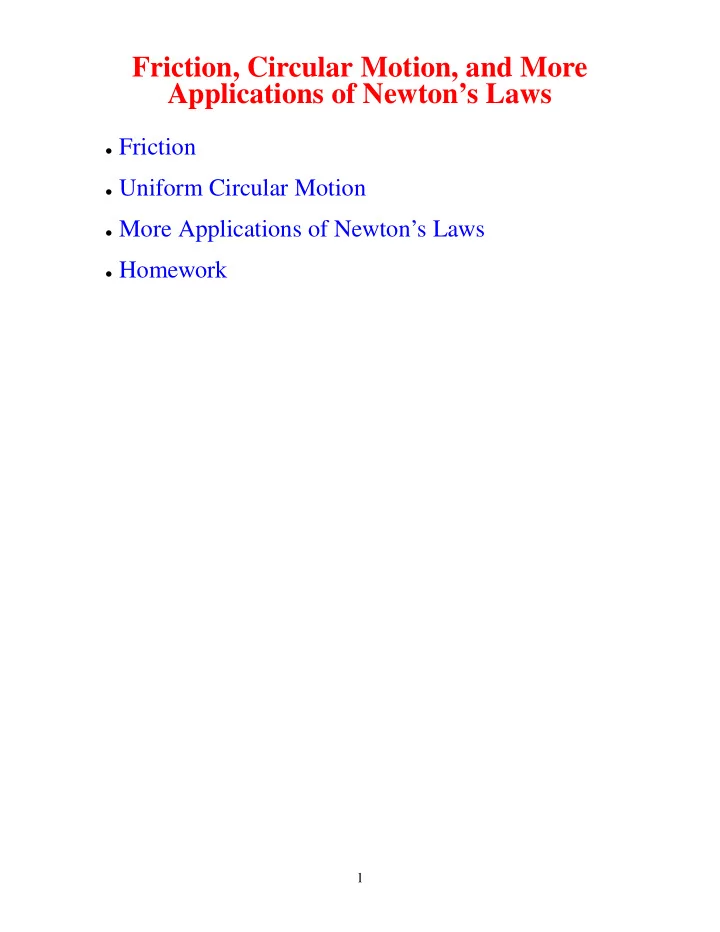

Friction, Circular Motion, and More Applications of Newton’s Laws • Friction • Uniform Circular Motion • More Applications of Newton’s Laws • Homework 1
Friction • Kinetic friction f k = µ k n where µ k is the coefficient of kinetic friction and n is the magnitude of the normal force • Static friction f s ≤ µ s n where µ s is the coefficient of static friction • µ s > µ k for a given surface 2
Friction Example 1 A woman pulls a loaded sled, with a mass of 75 kg, along a horizontal surface at a constant speed. The woman is pulling with a rope at an angle of 42 ◦ with the horizontal and the coefficient of friction between the runners and the snow is 0.1. What is the tension in the rope? 3
Friction Example 1 Solution A woman pulls a loaded sled, with a mass of 75 kg, along a horizontal surface at a constant speed. The woman is pulling with a rope at an angle of 42 ◦ with the horizontal and the coefficient of friction between the runners and the snow is 0.1. What is the tension in the rope? � F x = T cos φ − f k = 0 (1) � F y = T sin φ + N − mg = 0 (2) (1) T cos φ = µ k N ⇒ N = T cos φ µ k T sin φ + T cos φ (2) = mg ⇒ µ k µ k mg T = µ k sin φ + cos φ � 9 . 8 m/s 2 � T = (0 . 1) (75 kg ) (0 . 1) sin 42 ◦ + cos 42 ◦ = 91 N 4
Friction Example 2 You are driving your car at 24 m/s. What is the shortest distance in which you can brake to a halt? The coefficient of static friction between the tires and the road is 0.6. 5
Friction Example 2 Solution You are driving your car at 24 m/s. What is the shortest distance in which you can brake to a halt? The coefficient of static friction between the tires and the road is 0.6. y n f s x mg � F x = − f s = ma x − µ s n = ma x a x = µ s n m � F y = n − mg = 0 n = mg a x = − µ s g v xi = 24 m/s v xf = 0 x i = 0 x f =? v 2 xf = v 2 xi + 2 a x ( x f − x i ) (24 m/s ) 2 x f = − v 2 = v 2 xi xi 2 µ s g = 2 (0 . 6) (9 . 8 m/s 2 ) = 49 m 2 a x 6
Uniform Circular Motion • Centripetal acceleration a c = v 2 r • Centripetal force F c = ma c = mv 2 r 7
The Conical Pendulum 8
The Conical Pendulum � F y = T cos θ − mg = 0 T = mg cos θ � F r = T sin θ = mv 2 r mg tan θ = mv 2 r � v = rg tan θ � v = Lg sin θ tan θ The period of the motion is � T = 2 πr 2 πr � L cos θ � � = √ rg tan θ = 2 π � � � v g 9
Homework 9 - Due Wed. Sept. 29 • Read Sections 3.4 & 5.1-5.2 • Answer questions 5.1, 5.2 & 5.6 • Do problems 3.27, 5.3, 5.5, 5.7, 5.11, 5.13 & 5.16 10
Recommend
More recommend